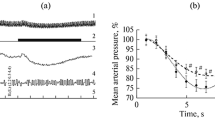Summary
From the unanaesthetized cat sympathetic action potentials were recorded by means of implantable electrodes. The recorded sympathetic activity was correlated with the states of sleep and wakefulness. The reactions on asphyxia as well as on acoustic and emotional stimuli were studied.
The following results were obtained:
During synchronized sleep the sympathetic activity was not significantly increased in relation to wakefulness and relaxed wakefulness. During desynchronized sleep, the sympathetic activity was decreased significantly to zero except for some periods of flaring up. Arousal as well as alertness reactions were accompanied by a decrease of sympathetic activity. A strong increase of sympathetic activity was observed during emotional stress and during asphyxia.
The results were discussed in respect to authors, who have made suggestions concerning sympathetic activity after measurement of circulation parameters. It was found that the renal sympathetic nerve shows changes of activity, as proposed as generally valid for the sympathetic nervous system, whereas an influence of changes in sympathetic activity on renal blood flow seems to exist only during strong activation.
Zusammenfassung
Es wird eine Methode beschrieben, mit Hilfe implantierter Ableite-Elektroden sympathische Aktionspotentiale über längere Zeit vom nichtnarkotisierten Tier zu registrieren. Die abgeleitete sympathische Aktivität wird mit den Stadien Schlaf-Wach-Rhythmik korreliert. Außerdem wird die Antwort auf Schallreize, Asphyxie und emotionelle Reize untersucht.
Es ergaben sich folgende Befunde:
Im synchronisierten Schlaf ist die sympathische Aktivität nicht signifikant erhöht gegenüber Wachheit mit Motorik oder Ruhe. Im desynchronisierten Schlaf ist die sympathische Aktivität signifikant vermindert auf Null, abgesehen von einigen Episoden des Wiederaufflackerns. Weck- und Aufmerksamkeitsreaktionen sind von einer Verminderung der sympathischen Aktivität begleitet. Eine starke Erhöhung der sympathischen Aktivität wurde bei emotionellem Streß und bei Asphyxie beobachtet. Die Befunde werden verglichen mit Befunden von Autoren, die aufgrund von Kreislaufmessungen Aussagen über die Sympathikusaktivität gemacht haben. Dabei wird gefunden, da\ der Nierensympathikus sich so verhält, wie von den meisten Autoren aus Kreislaufmessungen für den Sympathikus ganz allgemein geschlossen wurde. Ein Einfluß der Veränderungen der Aktivität des Nierensympathikus auf die Nierendurchblutung scheint nur bei starker Aktivierung zu bestehen.
Similar content being viewed by others
References
Bacelli, G., M. Guazzi, G. Monica andA. Zanchetti, Role of sympathetic system in circulatory patterns of desynchronized sleep in cat. Proc. IUPS7, 22 (1968).
Berlucchi, G., G. Moruzzi, G. Salvi andP. Strata, Pupil behavior and ocular movements during synchronized and desynchronized sleep. Arch. Ital. Biol.102, 230–244 (1964).
Blaschko, H., Amine oxidase and amine metabolism. Pharmacol. Rev.4, 415 (1952).
Bonvallet, M., P. Dell andG. Hiebel, Tonus sympathique et activité électrique corticale. EEG Clin. Neurophysiol.6, 119–144 (1954).
Brod, J., Die Nieren, Physiologie, klinische Physiologie und Klinik, p. 71 (Berlin 1964).
Bronk, D. W. andL. K. Ferguson, Impulses in cardiac sympathetic nerves. Proc. Soc. Except. Biol. Med.30, 339 (1932).
Candia, O., E. Favale, A. Giussani, G. F. Rossi, Blood pressure during natural sleep and during sleep induced by electrical stimulation of the brain stem reticular formation. Arch. Ital. Biol.100, 216–233 (1962).
Cassel, M. M., B. Ghelarducci, P. L. Marchiafava andO. Pompeiano, Phasic changes in blood pressure and heart rate during the rapid eye movement episodes of desynchronized sleep in unrestrained cats. Arch. Ital. Biol.102, 530–544 (1964).
Gootman, P. M. andM. I. Cohen, Efferent splanchnic actvity and systemic arterial pressure. Amer. J. Physiol.219, 897–903 (1970).
Guazzi, M. andA. Zanchetti, Blood pressure and heart rate during natural sleep of the cat and their regulation by control sinus and aortic reflexes. Arch. Ital. Biol.103, 789–817. (1965).
Heinemann, H., G. Stock, H. Baumgarten, V. Sturm andV. Thämer, Die Interferenz von cardio-vasculären Antworten und affektivem Verhalten von Katzen bei elektrischer Reizung limbischer Strukturen und die Rolle des Blutdrucks auf die verschiedenen Verhaltensmuster. Pflügers Arch. ges. Physiol.312, 113 (1969).
Jouvet, M., Physiological role of the catecholamine containing neurons of the brainstem of the cat. Symposium “Central and Peripheral Adrenergic Systems”. Warsaw, 1971.
Jung, Correlation of bioelectrical and autonomic phenomena with alterations of consciousness and arousal in man. Brain mechanisms and consciousness, p. 310 (Oxford 1954).
Kirchheim, H., Effect of common carotid occlusion on arterial blood pressure and on kidney flow in unanaesthetized dogs. Pflügers Arch. ges. Physiol.306, 119 (1969).
Kirchheim, H. andR. Gross, Das Verhalten der Nierendurchblutung und des Nierenumfanges bei Blutdrucksteigerungen durch doppelseitigen Carotisverschluß oder Schrittmachertachykardie. Pflügers Arch. ges. Physiol.320, 79 (1970).
Kirchner, F., Influences of the sympathetic nervous system on the regulation of pupil size. XIth Congress of the Polish Physiological Society, Szczecin, 1969.
Kirchner, F., Die Beziehungen zwischen Kreislaufregulation und Pupillenbewegung. Symposium “Die normale und die gestörte Pupillenbewegung”, Bad Nauheim, 1972.
Kirchner, F., F. Lamprecht, A. Philippi andR. Steinriede, Die Beziehung zwischen der Aktivität sympathischer Nierennerven und der Plasmareninaktivität bei narkotisierten Katzen. Z. Kreislaufforschg.61, 52–59 (1972).
Koepchen, H. P., Die Blutdruckrhythmik (Darmstadt 1962).
Wallin, B. G., K. E. Hagbarth, A. Hongell andW. Delius, Sympathetic activity in human skin and muscle nerves. Proc. IUPS9, 594 (1971).
Walther, O. E., M. Iriki andE. Simon, Antagonistic changes of blood flow sympathetic activity in different vascular beds following central thermal stimulation. II. Cutaneous and visceral sympathetic activity during heating and cooling in anaesthetized rabbits and cats. Pflügers Arch. ges. Physiol.319, 162–184 (1970).
Weidinger, H. andV. Leschhorn, Sympathische Tonisierung und rhythmische Blutdruckschwankungen. Z. Kreislaufforschg.53, 985–1002 (1964).
Author information
Authors and Affiliations
Additional information
With 9 figures and 1 table
Rights and permissions
About this article
Cite this article
Kirchner, F. Correlations between changes of activity of the renal sympathetic nerve and behavioural events in unrestrained cats. Basic Res Cardiol 69, 243–256 (1974). https://doi.org/10.1007/BF01906205
Received:
Issue Date:
DOI: https://doi.org/10.1007/BF01906205



